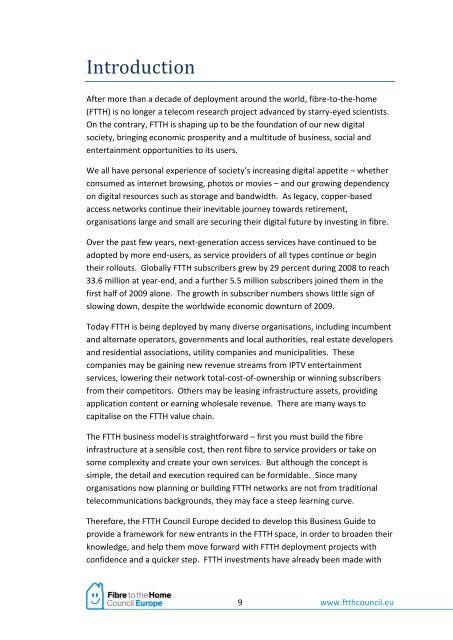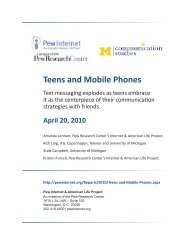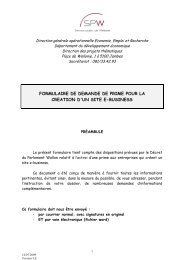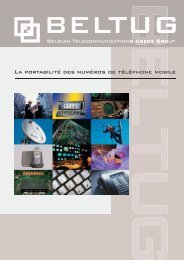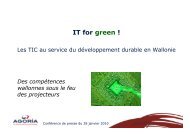You also want an ePaper? Increase the reach of your titles
YUMPU automatically turns print PDFs into web optimized ePapers that Google loves.
Introduction<br />
After more than a decade of deployment around the world, fibre-to-the-home<br />
(<strong>FTTH</strong>) is no longer a telecom research project advanced by starry-eyed scientists.<br />
On the contrary, <strong>FTTH</strong> is shaping up to <strong>be</strong> the foundation of our new digital<br />
society, bringing economic prosperity and a multitude of business, social and<br />
entertainment opportunities to its users.<br />
We all have personal experience of society’s increasing digital appetite – whether<br />
consumed as internet browsing, photos or movies – and our growing dependency<br />
on digital resources such as storage and bandwidth. As legacy, copper-based<br />
access networks continue their inevitable journey towards retirement,<br />
organisations large and small are securing their digital future by investing in fibre.<br />
Over the past few years, next-generation access services have continued to <strong>be</strong><br />
adopted by more end-users, as service providers of all types continue or <strong>be</strong>gin<br />
their rollouts. Globally <strong>FTTH</strong> subscri<strong>be</strong>rs grew by 29 percent during 2008 to reach<br />
33.6 million at year-end, and a further 5.5 million subscri<strong>be</strong>rs joined them in the<br />
first half of 2009 alone. The growth in subscri<strong>be</strong>r num<strong>be</strong>rs shows little sign of<br />
slowing down, despite the worldwide economic downturn of 2009.<br />
Today <strong>FTTH</strong> is <strong>be</strong>ing deployed by many diverse organisations, including incum<strong>be</strong>nt<br />
and alternate operators, governments and local authorities, real estate developers<br />
and residential associations, utility companies and municipalities. These<br />
companies may <strong>be</strong> gaining new revenue streams from IPTV entertainment<br />
services, lowering their network total-cost-of-ownership or winning subscri<strong>be</strong>rs<br />
from their competitors. Others may <strong>be</strong> leasing infrastructure assets, providing<br />
application content or earning wholesale revenue. There are many ways to<br />
capitalise on the <strong>FTTH</strong> value chain.<br />
The <strong>FTTH</strong> business model is straightforward – first you must build the fibre<br />
infrastructure at a sensible cost, then rent fibre to service providers or take on<br />
some complexity and create your own services. But although the concept is<br />
simple, the detail and execution required can <strong>be</strong> formidable. Since many<br />
organisations now planning or building <strong>FTTH</strong> networks are not from traditional<br />
telecommunications backgrounds, they may face a steep learning curve.<br />
Therefore, the <strong>FTTH</strong> Council Europe decided to develop this <strong>Business</strong> <strong>Guide</strong> to<br />
provide a framework for new entrants in the <strong>FTTH</strong> space, in order to broaden their<br />
knowledge, and help them move forward with <strong>FTTH</strong> deployment projects with<br />
confidence and a quicker step. <strong>FTTH</strong> investments have already <strong>be</strong>en made with<br />
9 www.ftthcouncil.eu


